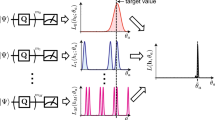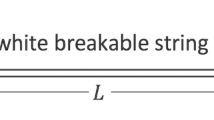Abstract
In this paper, we consider the quantum switch, which is one of the indefinite causal structures, in the study of quantum channel estimation. We show that such an indefinite causal order cannot provide any advantage for estimating quantum channels when the Kraus operators of the channel are commutative. We investigate the effects of the quantum switch when studying unitary qubit channels and amplitude damping qubit channels with noncommutative Kraus operators.
Similar content being viewed by others
Data Availability
This manuscript has no associated data
References
Fujiwara, A.: Quantum channel identification problem. Phys. Rev. A 63(4), 042304 (2001)
Fujiwara, A., Algoet, P.: One-to-one parametrization of quantum channels. Phys. Rev. A 59, 3290–3294 (1999)
Helstrom, C.: Minimum mean-squared error of estimates in quantum statistics. Phys. Lett. A 25(2), 101–102 (1967)
Holevo, A.S.: Probabilistic and Statistical Aspects of Quantum Theory. North-Holland, Amsterdam (1982)
Maccone, L., Cillis, G.D.: Robust strategies for lossy quantum interferometry. Phys. Rev. A 79(2), 023812 (2008)
Chiribella, G., D’Ariano, G.M., Perinotti, P.: Memory effects in quantum channel discrimination. Phys. Rev. Lett. 101(18), 180501 (2008)
Van, D.W., D’Ariano, G.M., Mauro, E.A., et al.: Optimal quantum circuits for general phase estimation. Phys. Rev. Lett. 98(9), 090501 (2007)
Takeoka, M., Wilde, M.M.: Optimal estimation and discrimination of excess noise in thermal and amplifier channels (2016). arXiv:1611.09165
Wu, X., Duan, R.: Exact quantum search by parallel unitary discrimination schemes. Phys. Rev. A 78(1), 012303 (2008)
Duan, R., Guo, C., Li, C.K., Li, Y.: Parallel distinguishability of quantum operations. In: 2016 IEEE International Symposium on Information Theory (ISIT), Barcelona, Spain, pp. 2259–2263 (2016)
Collins, D., Stephens, J.: Depolarizing-channel parameter estimation using noisy initial states. Phys. Rev. A 92(3), 032324 (2015)
Liu, J., Yuan, H.: Quantum parameter estimation with optimal control. Phys. Rev. A 96(1), 012117 (2017)
Oreshkov, O., Costa, F., Brukner, Č: Quantum correlations with no causal order. Nat. Commun. 3(10), 1092 (2012)
Chiribella, G., D’Ariano, G.M., Perinotti, P., et al.: Quantum computations without definite causal structure. Phys. Rev. A 88(2), 022318 (2013)
Araújo, M., Guérin, P.A., Baumeler, Ä.: Quantum computation with indefinite causal structures. Phys. Rev. A 96(5), 052315 (2017)
Feix, A., Araújo, M., Brukner, Č: Quantum superposition of the order of parties as a communication resource. Phys. Rev. A 92(5), 052326 (2015)
Araújo, M., Costa, F., Brukner, Č: Computational advantage from quantum-controlled ordering of gates. Phys. Rev. Lett. 113(25), 250402 (2014)
Ebler, D., Salek, S., Chiribella, G.: Enhanced communication with the assistance of indefinite causal order. Phys. Rev. Lett. 120(12), 120502 (2018)
Goswami, K., Costa, F.: Classical communication through quantum causal structures. Phys. Rev. A 103(4), 042606 (2021)
Chiribella, G., Banik, M., Bhattacharya, S.S., et al.: Indefinite causal order enables perfect quantum communication with zero capacity channel. New J. Phys. 23(3), 033039 (2021)
Chiribella, G.: Perfect discrimination of no-signalling channels via quantum superposition of causal structures. Phys. Rev. A 86(4), 040301 (2012)
Bavaresco, J., Murao, M., Quintino, M.T.: Strict hierarchy between parallel, sequential, and indefinite-causal-order strategies for channel discrimination. Phys. Rev. Lett. 127(20), 200504 (2021)
Bavaresco, J., Murao, M., Quintino, M.T.: Unitary channel discrimination beyond group structures: advantages of sequential and indefinite-causal-order strategies. J. Math. Phys. 63(4), 042203 (2022)
Frey, M.: Indefinite causal order aids quantum depolarizing channel identification. Quant. Inf. Process. 18(4), 96–115 (2019)
Zhao, X.B., Yang, Y.X., Chiribella, G.: Quantum metrology with indefinite causal order. Phys. Rev. Lett. 124(19), 190503 (2020)
Yin, P., Zhao, X.B., Yang, Y.X., et al.: Experimental super-Heisenberg quantum metrology with indefinite gate order. Nat. Phys. 8, 1–6 (2023)
Mukhopadhyay, C., Gupta, M.K., Pati, A.K.: Superposition of causal order as a metrological resource for quantum thermometry (2018). arXiv: 1812.07508
Chapeau-Blondeau, F.: Noisy quantum metrology with the assistance of indefinite causal order. Phys. Rev. A 103(3), 032615 (2021)
Chapeau-Blondeau, F.: Indefinite causal order for quantum metrology with quantum thermal noise. Phys. Lett. A 447, 128300 (2022)
Kurdzialek, S., Gorecki, W., Albarelli, F., Demkowicz-Dobrzanski, R.: Using adaptiveness and causal superpositions against noise in quantum metrology (2022). arXiv: 2212.08106
Liu, Q.S., Hu, Z.H., Yuan, H., Yang, Y.X.: Optimal strategies of quantum metrology with a strict hierarchy. Phys. Rev. Lett. 130, 070803 (2023)
Lu, X.M., Wang, X., Sun, C.P.: Quantum Fisher information flow and non-Markovian processes of open systems. Phys. Rev. A 82(4), 042103 (2010)
Fraïsse, J.M.E., Braun, D.: Quantum channel-estimation with particle loss: GHZ versus W states. Quant. Meas. Quant. Metrol. 3(1), 53–67 (2016)
Ji, Z., Wang, G., Duan, R., et al.: Parameter estimation of quantum channels. IEEE Trans. Inf. Theory 54(11), 5172–5185 (2008)
Zhong, W., Sun, Z., Ma, J., et al.: Fisher information under decoherence in Bloch representation. Phys. Rev. A 87(2), 022337 (2013)
Šafránek, D.: Simple expression for the quantum Fisher information matrix. Phys. Rev. A 97(4), 042322 (2018)
Kraus, K.: States, Effects, and Operations: Fundamental Notions of Quantum Theory. Springer, Berlin (1983)
Nielsen, M.A., Caves, C.M., Schumacher, B., Barnum, H.: Information-theoretic approach to quantum error correction and reversible measurement. Proc. R. Soc. A Math. Phys. Eng. Sci. 454(1969), 277–304 (1998)
Suzuki, J.: Entanglement detection and parameter estimation of quantum channels. Phys. Rev. A 94(4), 042306 (2016)
Acknowledgements
Z. Yin was partially supported by NSFC No. 12031004.
Author information
Authors and Affiliations
Corresponding author
Ethics declarations
Conflict of interest
No conflict of interest exits in this manuscript
Additional information
Publisher's Note
Springer Nature remains neutral with regard to jurisdictional claims in published maps and institutional affiliations.
Appendices
Appendix A: Generators of Lie algebras su(2) and su(4)
The generators of Lie algebra su(2) are given by
And the generators of Lie algebra su(4) are given by
Appendix B: Coefficients of \(\rho _\theta \) in (29)
Recall that
The generalized Bloch expression of \(\rho _\theta \) is given by
with coefficients
Rights and permissions
Springer Nature or its licensor (e.g. a society or other partner) holds exclusive rights to this article under a publishing agreement with the author(s) or other rightsholder(s); author self-archiving of the accepted manuscript version of this article is solely governed by the terms of such publishing agreement and applicable law.
About this article
Cite this article
Gu, J., Yin, Z. & Li, L. Quantum channel estimations via indefinite causal order. Quantum Inf Process 22, 369 (2023). https://doi.org/10.1007/s11128-023-04118-7
Received:
Accepted:
Published:
DOI: https://doi.org/10.1007/s11128-023-04118-7




